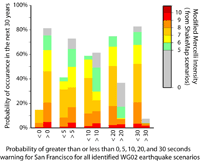| Home |
| About ElarmS |
| Application? - tell us |
| California |
| South Korea |
| Turkey |
| Methodology |
| Research Highlights |
| Technical Publications |
| Press Highlights |
| Contact us |
| Acknowledgements |
What is earthquake early warning?
- Earthquake early warning systems can provide a few to a few tens of seconds warning prior to damaging ground shaking.
- Earthquake early warning systems are currently operational in Mexico, Taiwan and Japan but not in the United States.
Why do we need earthquake early warning?
- Current earthquake mitigation strategies focus on long-term ground shaking forecasts that can be used in building design and rapid post-event notification used for emergency response.
- Early warning systems allow for short-term mitigation including slowing and stopping of transportation systems, switching industrial and utility systems to a safe mode, and taking personal protective measures.
- Early warning would reduce the number of casualties and the cost of earthquakes in California.
 How much warning?
How much warning?
- A few seconds to a few tens of seconds. The amount depends on how far from an earthquake you are.
- A study of warning times for the city of San Francisco shows that it is likely that the city would receive more than 20 sec for the most damaging earthquakes.
What is ElarmS?
ElarmS, or Earthquake Alarm Systems, can provide warning of ground shaking during an earthquake. The objective is to rapidly detect the initiation of an earthquake, estimate the level of ground shaking to be expected, and issue a warning before significant ground shaking starts. This can be done by detecting the first energy to radiate from an earthquake, the P-wave energy, which rarely causes and damage. Using the arrival time of the P-wave at the surface and the frequency content, ElarmS estimates the location and the magnitude of the earthquake. The anticipated ground shaking across the affected region is then estimated using empirical attenuation relations. The methodology can provide warning before the S-wave arrival which usually causes most of the damage.
Why ElarmS?
Feasibility studies of the ElarmS methodology show that the amount of warning time would range from a few seconds to a few tens of seconds depending on your distance from the epicenter of the earthquake. This is enough time to slow and stop transportation such as trains, taxiing planes and cars entering bridges and tunnels; to move away from dangerous machines or chemicals at work, and take cover under a desk; to automatically shut down and isolate industrial systems. Taking these actions before shaking starts can reduce damage and casualties during an earthquake. It can also prevent cascading failures in the aftermath of an event. For example, isolating utilities before shaking can reduce the number of fire initiations.
Implementation across California
Seismologists across California are currently planning real-time testing of earthquake early warning across the state. We want to hear from companies, institutions, government agencies and individuals about how a few seconds to a few tens of seconds warning could be used to reduce the casualties and damage caused by an earthquake in the state. If you have ideas please send them to us by filling out the form on this website.
This information is maintained by Richard Allen at UC Berkeley
